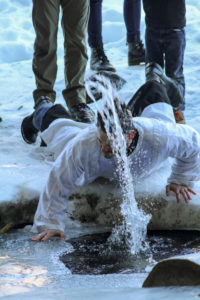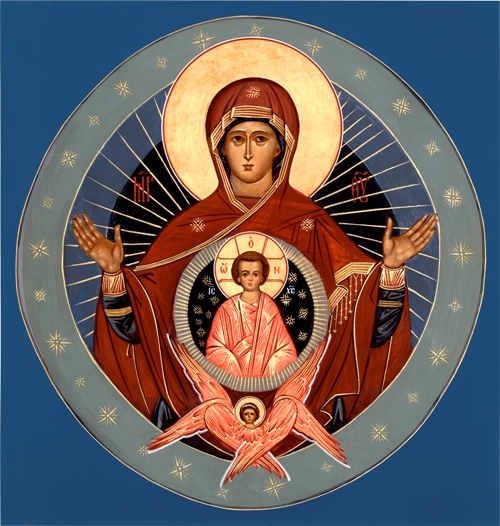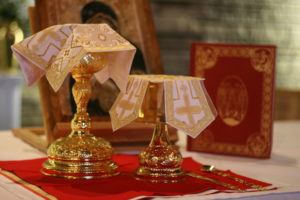Wyoming Catholic College and the Eastern Churches
Amongst Newman Guide Colleges, there may well be no better place to (in the words of John Paul II) breathe with both lungs than Wyoming Catholic College. While the College is not an exclusively Byzantine college, and students who attend will also be immersed in the riches of the Western liturgical and theological tradition, a Byzantine Catholic who comes to the high mountain desert of Wyoming will readily find that he simultaneously encounters the glory of the West, while being nurtured in his own tradition as well.
With a full-time Byzantine chaplain, an Eastern Catholic theologian serving as academic dean, and around 1/10th of the student body claiming membership in one of the Eastern Catholic Churches, it’s no wonder that the National Catholic Register recently highlighted how well Wyoming Catholic breathes with two lungs. In addition, there are several ways that the College especially cultivates the Byzantine charism.
 Inculturation in Western Civilization: While the rhetoric about studying Western civilization often focuses on what we would characterize as Latin Christendom, the Byzantine tradition is fundamentally part of that same sweep. Our students study the ancient Greek and Roman cultures which are common roots for both Byzantines and Latins, and then at other points in the curriculum they consider the rise of Constantine, the legal reforms of the great Byzantine Emperor Theodosius, and the tensions between the Byzantine and Holy Roman Emperors. Throughout the humanities, music, art, philosophy and theology courses, Byzantine and Slavic works are considered alongside the great works of Western Europe. Our students thus are acquainted with the full breadth of Western Civilization, even the Eastern part.
Inculturation in Western Civilization: While the rhetoric about studying Western civilization often focuses on what we would characterize as Latin Christendom, the Byzantine tradition is fundamentally part of that same sweep. Our students study the ancient Greek and Roman cultures which are common roots for both Byzantines and Latins, and then at other points in the curriculum they consider the rise of Constantine, the legal reforms of the great Byzantine Emperor Theodosius, and the tensions between the Byzantine and Holy Roman Emperors. Throughout the humanities, music, art, philosophy and theology courses, Byzantine and Slavic works are considered alongside the great works of Western Europe. Our students thus are acquainted with the full breadth of Western Civilization, even the Eastern part.- Theology: The theology sequence covers eight semesters, and during that time students encounter not only St. Thomas Aquinas and St. Augustine, but are first and foremost immersed in the richness of Scripture. From there on students study St. Gregory the Theologian, St. Athanasius of Alexandria, St. Basil the Great, St. Cyril of Alexandria, St. John Chrysostom, St. Maximus the Confessor, St. John of Damascus, Pseudo-Dionysius the Aeropagite, St. Ephraim the Syrian, St. Theodore the Studite, and the texts of the first seven Ecumenical Councils. During their senior year, many of the students are acquainted with the Code of Canons of the Eastern Churches. In addition, the College offers optional practical theology courses on spirituality and previous topics have included: praying with icons, praying with the Byzantine Liturgy, and the wisdom of the Desert Fathers. In short, few Colleges have a theological core curriculum with as profound an engagement with the spirituality and
wisdom of the Eastern Churches as does Wyoming Catholic College.
 Icons and Church Architecture: In their senior year art history courses, students devote a substantial portion of the course to the study of the history, ascetics, and theology of the iconographic and architectural tradition of the Eastern Church. It is one of the best treatments of the artistic tradition of the Eastern Churches available at an integrated Catholic liberal arts college.
Icons and Church Architecture: In their senior year art history courses, students devote a substantial portion of the course to the study of the history, ascetics, and theology of the iconographic and architectural tradition of the Eastern Church. It is one of the best treatments of the artistic tradition of the Eastern Churches available at an integrated Catholic liberal arts college.- Lectures: The College has hosted several lectures focused on Byzantine spirituality, theology, and history. Recent topics have included: the Byzantine Churches and the New Evangelization, the observance of the Great Fast, and the nature of the Byzantine theological tradition. More lectures will continue to be a regular feature of the life of the College. For examples of past lectures and podcasts related to the Byzantine life of the College and studies of Eastern saints see here, here, here, and here.
- The Byzantine Pedagogy: The great saints of the Byzantine tradition like St. Gregory the Theologian, Maximus the Confessor, or Theodore the Studite followed a plan of education similar to that offered by Wyoming Catholic College. These great men were taught mathematics, poetry, rhetoric, and philosophy. But not only were they formed in these classical disciplines, they all also spent time in the desert, devoting themselves to self-reflection, prayer, and self-discipline and immersed in the riches of their liturgical tradition. It was the combination of classical learning, liturgical worship and a spiritually rich immersion in the wilderness that made these men the great leaders of the Church. Students who come to the high mountain desert of Wyoming will receive nothing less. They will be steeped in the classical tradition, a rich liturgical life, and the immediate encounter with the wilderness. One could say this is the education model of the Byzantine tradition.
 Liturgy Since its beginning, Wyoming Catholic has sought to ensure that the Byzantine liturgical heritage is given a presence on campus. At present, the College has a full-time Byzantine chaplain, Fr. David Anderson. Every weekend there is Great Vespers, Matins and Divine Liturgy (the latter on both Saturday and Sunday). During the week the offerings vary according to the Liturgical calendar, and confessions are heard three times a week according to the Byzantine tradition.
Liturgy Since its beginning, Wyoming Catholic has sought to ensure that the Byzantine liturgical heritage is given a presence on campus. At present, the College has a full-time Byzantine chaplain, Fr. David Anderson. Every weekend there is Great Vespers, Matins and Divine Liturgy (the latter on both Saturday and Sunday). During the week the offerings vary according to the Liturgical calendar, and confessions are heard three times a week according to the Byzantine tradition.

